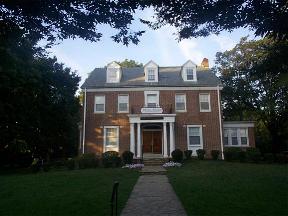The history of Jews in Ohio dates back to 1817, when Joseph Jonas, a pioneer, came from England and made his home in Cincinnati. He drew after him a number of English Jews, who held Orthodox-style divine service for the first time in Ohio in 1819, and, as the community grew, organized themselves in 1824 into the first Jewish congregation of the Ohio Valley, the B'ne Israel. This English immigration was followed in the next two decades by the coming of German immigrants who, in contrast, were mostly Reform Jews. A Bavarian, Simson Thorman, settled in 1837 in Cleveland, then a considerable town, which thus became the second place in the state where Jews settled. Thorman was soon followed by countrymen of his, who in 1839 organized themselves into a congregation called the Israelitish Society. The same decade saw an influx of German Jews into Cincinnati, and these in 1841 founded the Bene Yeshurun congregation. To these two communities the Jewish history of Ohio was confined for the first half of the 19th century. In 1850 Ohio had six congregations: four in Cincinnati and two in Cleveland.

Golden Hill Cemetery is located at 5025 North 42nd Street in the North Omaha neighborhood of Omaha, Nebraska.

Temple Israel Cemetery, also known as Pleasant Hill Cemetery, is located at 6412 North 42 Street in the North Omaha neighborhood of Omaha, Nebraska.
The history of the Jews in Omaha, Nebraska, goes back to the mid-1850s.

Jews have inhabited the city of Galveston, Texas, for almost two centuries. The first known Jewish immigrant to the Galveston area was Jao de la Porta, who, along with his brother Morin, financed the first settlement by Europeans on Galveston Island in 1816. de la Porta was born in Portugal of Jewish parentage and later became a Jewish Texan trader. In 1818, Jean Laffite appointed de la Porta supercargo for the Karankawa Indian trade. When Laffite left Galveston Island in 1820, de la Porta became a full-time trader.
Congregation B'nai Shalom is a Reform Jewish synagogue located at 1545 Bushkill Street, in Easton, Pennsylvania, in the United States. The congregation was formed on August 1, 2020, following the merger of two former congregations.
Congregation Beth Israel Abraham Voliner, abbreviated as BIAV, is an Orthodox Jewish congregation and synagogue, located 9900 Antioch Road, in Overland Park, in the Kansas City Metropolitan Area of Kansas, in the United States.
The history of the Jews in Vancouver in British Columbia, Canada has been noted since the mid-19th century.

B'nai Jeshurun is a non-denominational Jewish synagogue located at 257 West 88th Street and 270 West 89th Street, on the Upper West Side of Manhattan, in New York City, New York, United States.
Daniel Block was a Jewish leader who founded the B'nai B'rith synagogue in St. Louis, Missouri. He lived for only four years in the United States but he made important contributions on the culture of the St. Louis Jewish community to which he belonged. Between his arrival in about 1848, and his death in 1853, he contributed greatly to the organization and development of B'nai El congregation.
B'nai Jeshurun may refer to the following Jewish synagogues:
Shaarey Tphiloh is a Modern Orthodox Jewish congregation and synagogue located at 400 Deering Avenue, in Portland, Maine, in the United States. The congregation says it is the oldest continuously operating synagogue in Portland. The name of the synagogue literally means "Gates of Prayer" in Hebrew.

Few Jews arrived in Baltimore, Maryland, in its early years. As an immigrant port of entry and border town between North and South and as a manufacturing center in its own right, Baltimore has been well-positioned to reflect developments in American Jewish life. Yet, the Jewish community of Baltimore has maintained its own distinctive character as well.

Historic Congregation B’nai Abraham, officially B’nai Abraham Chabad, is an Orthodox Jewish congregation and synagogue, located at 523-527 Lombard Street, in the Society Hill neighborhood of the Center City of Philadelphia, Pennsylvania, in the United States. Established as a congregation in 1874 and the current synagogue building completed in 1910, worshipers can access daily, Shabbat, and holy day services in the Ashkenazi rite. B'nai Abraham is home to a Jewish Preschool, as well as Lubavitch of Center City.

The Beth Olam Cemetery is a historic cemetery in Cypress Hills, Brooklyn, New York, United States. It is located in the city's Cemetery Belt, bisected by the border between Brooklyn and Queens.

Henry Monsky was a Jewish-American lawyer and communal leader from Omaha, Nebraska.
Aaron Mordecai Ashinsky was a Polish-born American rabbi. He spent most of his career in Pittsburgh, Pennsylvania.








